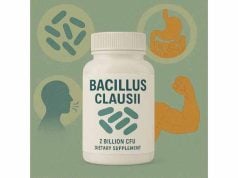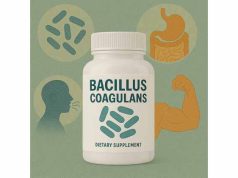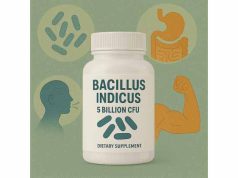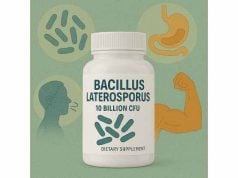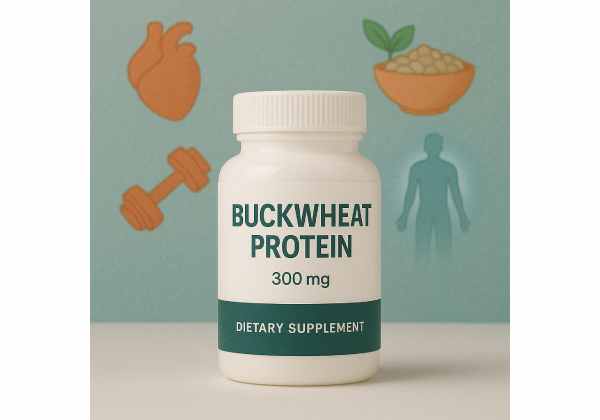
Buckwheat protein is emerging as a top plant-based supplement, offering a unique nutritional profile and a host of wellness benefits for athletes, vegetarians, vegans, and anyone seeking high-quality, allergen-free protein. Unlike many plant proteins, buckwheat delivers all nine essential amino acids, making it a “complete” protein source, with digestibility and bioavailability rivaling that of dairy and eggs. Derived from the seeds of the Fagopyrum esculentum plant, buckwheat protein also supplies fiber, antioxidants like rutin and quercetin, and key minerals, supporting muscle growth, recovery, blood sugar balance, and heart health. This comprehensive guide details the science, applications, dosing, and safety of buckwheat protein for daily nutrition and performance.
Key Takeaways
- Complete amino acid profile: Buckwheat protein provides all essential amino acids in balanced proportions, making it ideal for plant-based diets.
- Hypoallergenic and gluten-free: Safe for most with food sensitivities; contains no gluten, soy, or dairy.
- Supports muscle growth and recovery: Easily digestible, rich in BCAAs, and great for pre/post-workout nutrition.
- Blood sugar and heart health benefits: Natural bioactive compounds help maintain healthy glucose levels and support vascular function.
- Versatile in diet: Works well in shakes, baking, or as a supplement for all ages and lifestyles.
Table of Contents
- What is Buckwheat Protein? Origin, Nutrition, and Supplement Forms
- How Buckwheat Protein Works: Digestion, Bioavailability, and Absorption
- Proven Benefits of Buckwheat Protein for Muscle, Metabolism, and Wellness
- Buckwheat Protein Safety, Allergy Concerns, Side Effects, and Interactions
- Optimal Dosage: How to Use Buckwheat Protein for Best Results
- Frequently Asked Questions About Buckwheat Protein
What is Buckwheat Protein? Origin, Nutrition, and Supplement Forms
Buckwheat protein is extracted from the seeds of the Fagopyrum esculentum plant, an ancient pseudocereal cultivated in Asia, Europe, and North America. Despite its name, buckwheat is not related to wheat or other grains, and is naturally gluten-free. The seeds, when processed into flour or protein powder, yield a highly nutritious food with a rich history in traditional diets and a growing presence in the supplement world.
Botanical and Nutritional Background
- Origin: Buckwheat’s cultivation traces back thousands of years, with a central role in Russian, Chinese, and Japanese cuisines (think soba noodles and kasha).
- Seed composition: Buckwheat seeds are about 12–15% protein, with the remainder mostly complex carbohydrates, fiber, and beneficial phytonutrients.
Complete Protein Profile
What sets buckwheat apart from most other plant sources is its complete amino acid spectrum:
- All nine essential amino acids: Including lysine and methionine, often lacking in other plant proteins like rice, wheat, or corn.
- High in branched-chain amino acids (BCAAs): Especially leucine, isoleucine, and valine, which are crucial for muscle protein synthesis.
Additional Nutritional Highlights
- Rich in fiber: Promotes satiety, gut health, and stable blood sugar.
- Packed with minerals: Especially magnesium, iron, phosphorus, zinc, and manganese.
- Phytochemicals: Contains rutin, quercetin, and D-chiro-inositol, which contribute to its antioxidant, anti-inflammatory, and metabolic-supporting properties.
Types of Buckwheat Protein Supplements
- Concentrates: 50–70% protein content, often made by removing most starch and fiber.
- Isolates: 80–90% protein, processed to eliminate nearly all carbs and fats—ideal for maximizing protein intake.
- Blends: Combined with pea, rice, or hemp protein for a balanced flavor and nutrient profile.
- Hydrolyzed protein: Broken into smaller peptides for rapid absorption, used in sports supplements and medical nutrition.
Supplement Forms and Uses
- Powders: The most popular, mixes easily into shakes, smoothies, and recipes.
- Ready-to-drink formulas: Convenient for on-the-go nutrition.
- Protein bars and baked goods: Incorporated into energy bars, muffins, pancakes, or gluten-free breads.
Summary
Buckwheat protein stands out among plant-based supplements for its full amino acid profile, excellent digestibility, and robust nutritional benefits. It is suitable for all ages, dietary preferences, and fitness levels.
How Buckwheat Protein Works: Digestion, Bioavailability, and Absorption
The effectiveness of a protein supplement depends not just on its amino acid content, but also on how well the body can digest and utilize it. Buckwheat protein is highly regarded for its excellent digestibility and efficient absorption—factors that set it apart from many other plant proteins.
Digestion and Protein Quality
- Protein digestibility-corrected amino acid score (PDCAAS): Buckwheat protein boasts a PDCAAS of 0.75–0.93, higher than many plant proteins and close to animal proteins like egg and casein.
- Amino acid composition: High levels of lysine and arginine boost the biological value, as these are often limiting in grains and other plant foods.
Digestive Process
- Enzyme-friendly structure: Buckwheat’s proteins, primarily globulins and albumins, are easily broken down by digestive enzymes in the stomach and small intestine.
- Low in anti-nutrients: Unlike some legumes and grains, buckwheat contains minimal trypsin inhibitors and lectins, reducing the risk of impaired protein utilization.
Bioavailability and Muscle Support
- Rapid absorption: The high solubility of buckwheat protein allows for quick uptake of amino acids into the bloodstream, which is ideal for muscle repair and recovery.
- BCAA content: Supports anabolic (muscle-building) signaling and reduces exercise-induced muscle breakdown.
Gut and Immune Health
- Prebiotic fiber: Buckwheat protein supplements often retain some of the seed’s soluble fiber, feeding beneficial gut bacteria and promoting digestive regularity.
- Antioxidant action: Phytochemicals in buckwheat help reduce gut inflammation and may improve nutrient absorption over time.
Synergy with Other Nutrients
Buckwheat protein’s natural combination of amino acids, minerals, and antioxidants offers more holistic health support than protein isolates stripped of other nutrients. When blended with other plant proteins, buckwheat can further enhance the overall amino acid profile and digestibility of the mixture.
Practical Considerations
- Mixes easily: Buckwheat protein powder dissolves well in liquids without gritty texture or strong aftertaste.
- Suitable for all diets: Compatible with vegan, vegetarian, paleo, and gluten-free eating patterns.
Summary
Buckwheat protein’s superior digestibility and absorption, along with its low anti-nutrient content, make it a top choice for anyone seeking effective plant-based nutrition for muscle, metabolism, and daily health.
Proven Benefits of Buckwheat Protein for Muscle, Metabolism, and Wellness
Buckwheat protein is more than just a building block for muscle—it offers a broad spectrum of evidence-based health benefits, making it an asset to daily nutrition for active individuals, families, and anyone managing metabolic health.
1. Muscle Growth, Strength, and Recovery
- Complete amino acid spectrum: Fuels muscle protein synthesis as effectively as dairy or egg proteins, especially when combined with resistance exercise.
- Rich in BCAAs: Buckwheat is particularly high in leucine, which plays a key role in signaling muscle growth and reducing post-workout muscle soreness.
- Rapid repair: High bioavailability supports quicker recovery after intense training or injury.
2. Weight Management and Satiety
- Promotes fullness: The high protein and fiber content help curb hunger and support weight loss or maintenance by reducing overall calorie intake.
- Stable energy: Buckwheat protein does not cause blood sugar spikes, making it a smart choice for those managing appetite or energy levels.
3. Blood Sugar and Metabolic Health
- Lowers glycemic response: Buckwheat’s protein and fiber slow the absorption of glucose, supporting stable blood sugar after meals.
- Supports insulin sensitivity: D-chiro-inositol, a unique buckwheat component, may help improve insulin function in those at risk for metabolic syndrome or type 2 diabetes.
4. Cardiovascular and Antioxidant Benefits
- Heart-healthy nutrients: Magnesium, potassium, and bioactive compounds help relax blood vessels and reduce blood pressure.
- Antioxidant action: Rutin and quercetin protect blood vessels from oxidative damage and inflammation.
5. Allergy and Digestive Safety
- Hypoallergenic: Buckwheat protein rarely triggers allergic reactions, and its gluten-free nature makes it ideal for celiac sufferers.
- Supports gut health: The combination of protein, fiber, and phytochemicals fosters a balanced gut microbiome and digestive comfort.
6. Versatility and Environmental Impact
- Eco-friendly: Buckwheat cultivation requires less water and fewer pesticides than most animal-based or soy protein sources.
- Versatile in recipes: Suitable for smoothies, baking, pancakes, energy bars, and more—making daily protein intake easier and tastier.
Who Benefits Most?
- Athletes and fitness enthusiasts needing high-quality protein for recovery and performance.
- Vegetarians and vegans seeking a complete, plant-based protein.
- Individuals with gluten intolerance, food allergies, or digestive sensitivities.
- Anyone focused on metabolic, cardiovascular, or general wellness.
Summary
Buckwheat protein is a science-backed, nutrient-rich, and flexible protein source. It delivers proven benefits for muscle growth, blood sugar control, satiety, heart health, and beyond—suitable for nearly every diet and lifestyle.
Buckwheat Protein Safety, Allergy Concerns, Side Effects, and Interactions
Buckwheat protein is widely celebrated for being gentle on the digestive system, non-allergenic for most people, and naturally free from gluten and common allergens like dairy, soy, and nuts. However, as with any supplement or new dietary ingredient, understanding its potential risks, rare side effects, and important precautions is crucial for safe and optimal use.
General Safety Profile
- Hypoallergenic: Buckwheat is not a major allergen in most regions and is considered safer than wheat, soy, or milk proteins for individuals with food sensitivities or allergies.
- Gluten-free: Buckwheat is botanically unrelated to wheat and is naturally safe for those with celiac disease or gluten intolerance.
- Easily digested: Most people find buckwheat protein easy on the stomach, even in higher-protein diets or in those with sensitive digestion.
Possible Side Effects
- Digestive changes: Some users may notice mild gas, bloating, or increased stool frequency, especially when first adding a higher-protein, higher-fiber supplement to their routine. These effects usually resolve as your digestive system adapts.
- Rare allergy: True buckwheat allergy is uncommon but possible. Symptoms can include hives, itching, swelling, nausea, or in very rare cases, anaphylaxis. People with known buckwheat allergy or a history of multiple severe food allergies should avoid all buckwheat-based products.
Who Should Exercise Extra Caution?
- Children: Buckwheat is safe in food amounts for children, but supplemental protein should be dosed according to weight and age. Consult a pediatrician for young children or if giving concentrated protein powders.
- Pregnant and breastfeeding women: Buckwheat is generally safe as a food, but if using large supplemental doses, check with a healthcare provider.
- People with known seed or grain allergies: Although rare, cross-reactivity is possible, so proceed with care if you have a strong history of allergies.
- Chronic kidney disease: High-protein diets may not be suitable for those with advanced kidney disease—always follow medical advice.
Drug and Supplement Interactions
- Minimal interaction risk: Buckwheat protein does not typically interact with medications, but very high protein intake can affect absorption of certain drugs (as with all protein supplements). Maintain a consistent supplement routine and space protein intake away from sensitive medications if possible.
- Antidiabetic and antihypertensive drugs: Buckwheat’s natural effects on blood sugar and blood pressure may enhance the effect of these medications. Monitor levels regularly if using both.
Environmental and Contaminant Safety
- Choose reputable brands: Opt for protein powders that are tested for heavy metals, pesticides, and contaminants, especially if sourced from regions with variable agricultural standards.
- Organic options: Organic buckwheat protein ensures minimal pesticide residues and a lower environmental footprint.
Practical Safety Tips
- Start low, increase slowly: If new to buckwheat protein, begin with half a serving for several days to gauge your body’s response.
- Hydrate well: As with all high-protein foods, increase your water intake to support kidney function and healthy digestion.
- Store properly: Keep protein powders in a cool, dry place to prevent spoilage or rancidity.
Summary
Buckwheat protein is one of the safest and most digestible plant-based proteins available. For most people, it is a highly beneficial, low-risk supplement. As with any new food or supplement, mindful introduction and sourcing quality products are key to enjoying its benefits without side effects.
Optimal Dosage: How to Use Buckwheat Protein for Best Results
Achieving the full benefits of buckwheat protein depends on using the right amount, the best form for your needs, and integrating it smoothly into your daily nutrition. This section outlines practical dosage guidelines, timing, and tips for athletes, active individuals, and anyone boosting their plant-based protein intake.
Typical Dosage Recommendations
- General wellness (adults): 15–30 grams of buckwheat protein powder daily is sufficient for most adults, either in a single serving or divided between meals and snacks.
- Athletes or higher-protein needs: For muscle recovery, lean mass gain, or intense activity, 20–40 grams per serving, 1–2 times daily, is typical—especially post-workout or as a meal replacement.
- Children and teens: 0.5–1 gram per kilogram of body weight per day, split into meals and snacks, based on age and protein needs.
How to Use Buckwheat Protein Powder
- Shakes and smoothies: Add a scoop to your favorite liquid (water, plant milk, yogurt), blend with fruit, greens, or nut butters.
- Baking: Use in protein pancakes, muffins, granola bars, or gluten-free bread recipes—swap up to 1/4 of the flour for protein powder for extra nutrition.
- Oatmeal and porridge: Stir into hot cereals for a hearty, filling breakfast.
- Soups and stews: Mix in toward the end of cooking for a protein boost without altering flavor.
Best Timing for Buckwheat Protein
- Post-workout: For muscle repair and growth, consume within 30–60 minutes after exercise.
- Between meals: Use as a satisfying snack to curb cravings, or as a small meal to support weight management.
- Before bed: Can be used in the evening for overnight muscle recovery or as a nighttime satiating snack.
Tips for Maximizing Benefits
- Pair with carbohydrates: Combine with fruit, oats, or starchy vegetables post-workout to enhance muscle glycogen replenishment.
- Mix with other plant proteins: Blend with pea, hemp, or rice protein to diversify your amino acid profile and improve taste/texture if desired.
- Stay hydrated: Increased protein requires more fluids for optimal metabolism and kidney function.
Signs You May Need to Adjust Your Dosage
- Digestive upset or bloating: Lower your dose and increase gradually; ensure you’re drinking enough water.
- Plateaued results or hunger: Increase your intake slightly, especially if very active, growing, or recovering from illness.
Quality Considerations
- Look for minimal ingredients: Pure buckwheat protein with little to no added sugars, artificial sweeteners, or fillers is best.
- Check for certifications: Non-GMO, organic, and third-party tested products provide added assurance of safety and quality.
Summary
Buckwheat protein is easy to incorporate into meals, snacks, and recipes for all ages and activity levels. Follow recommended dosing and use creative ways to include it in your routine for best health and performance outcomes.
Frequently Asked Questions About Buckwheat Protein
Is buckwheat protein a complete protein?
Yes, buckwheat protein contains all nine essential amino acids, making it a complete protein and ideal for vegan and vegetarian diets.
Can people with celiac disease or gluten intolerance use buckwheat protein?
Absolutely. Buckwheat is naturally gluten-free and safe for those with celiac disease or gluten sensitivities.
What is the best way to take buckwheat protein?
Buckwheat protein is most commonly used in smoothies, shakes, baking, and protein bars. It blends easily and can be incorporated into both sweet and savory recipes.
Are there any side effects of buckwheat protein?
Side effects are rare but may include mild digestive discomfort if you’re not used to high-fiber, high-protein foods. True buckwheat allergy is extremely rare.
How does buckwheat protein compare to whey or soy protein?
Buckwheat protein rivals animal proteins in amino acid quality, is easier to digest than soy, and is hypoallergenic, making it a safe and effective alternative.
Is buckwheat protein safe for children and seniors?
Yes, buckwheat protein is suitable for all ages. Use appropriate serving sizes based on age, weight, and protein needs, and consult with a healthcare provider for young children.
Can buckwheat protein help with weight loss?
Yes, its high protein and fiber content promote satiety and can support healthy weight loss when used as part of a balanced diet and active lifestyle.
Disclaimer:
This article is for educational and informational purposes only. It is not medical advice and does not replace consultation with a qualified healthcare professional. Always consult your doctor or nutritionist before adding a new supplement to your routine, especially if you have any medical conditions or dietary restrictions.
If you found this guide useful, please share it on Facebook, X (formerly Twitter), or your favorite social media platform—and follow us for more evidence-based nutrition insights. Your support helps us continue producing quality health content for everyone!



